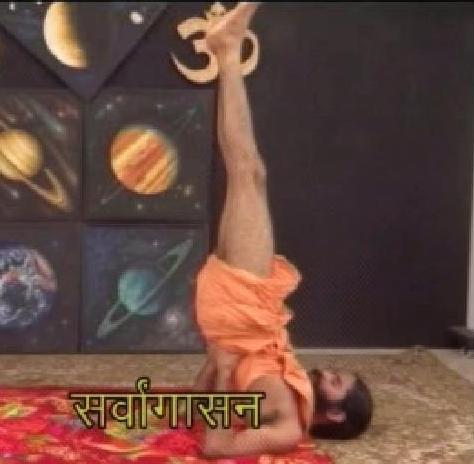Sarvangasana | Shoulderstand Pose
‘Sarvang’ is a Sanskrit word which means ‘all limbs’ or ‘complete body’. Sarvangasana or Shoulderstand Pose benefits the complete body.
Procedure
1. Lie down on the back comfortably. Keep legs straight touching each other, palms facing downwards.
2. Inhale through nostrils, waist and hips should remain on the floor, start lifting both the legs slowly upwards till it make 90° with the rest of the body. If it is tough, down facing arms can bear the load and help.
3. Now, lift the whole body up as much as possible with the support of both hands at the waist, elbow should be touching the floor to balance the body weight and to make a stand like structure. Feet should be jointed and stretched. Keep the eyes closed or looking at the toes. Breath normally.
4. This way, the total weight of body will come on to the shoulders. You can continue the supporting of hands to body till you have good practice or become able to keep it stood without support of hands. With hands support it is called ‘Salamba Sarvangasana’ and without hands support it is called ‘Nirlamba Sarvangasana’.
5. Reverse the procedure back to normal slowly and one by one. First remove hands, put the back on the floor then legs straight back to ‘Shavasana Pose’.
6. It is recommended to practice ‘Shavasana’ just after ‘Sarvangasana’ for the same duration so as to calm down the body. ‘Matsyasana’ is supplementary asana with Sarvangasana, which may also be practiced for optimum benefits after it, but before shavasana.
Duration
Practice this pose for the duration you feel comfortable, from 2 minutes to 30 minutes. Don’t over practice.
Benefits
1. Makes ‘Thyroid’ gland active and cures problems related to it like obesity and tiredness. Also cures problems related to Pituitary gland, Adrenal glands and other Genital glands.
2. All benefits of ‘Sarvangasana’ are like ‘Shirshasana’ while it is easier to practice than shirshasana. It is also beneficial for ‘lungs’ and can cure second and third stages of ‘Asthema’.
3. This asana is very good for abdominal organs, as flow of blood reversed towards head and abdomin gets relieved for that duration.


